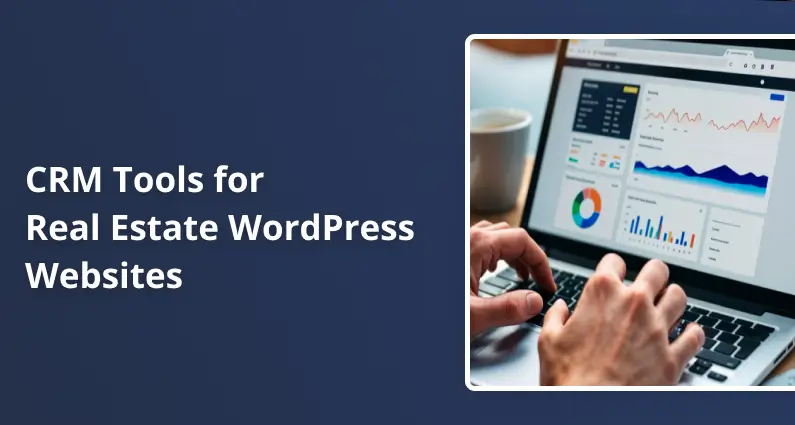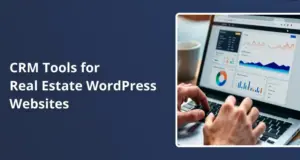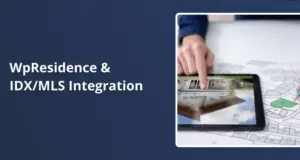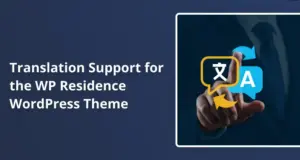Your real estate website looks fantastic. Property photos are crisp, listings are detailed, and the design makes visitors want to explore. But here’s the problem: beautiful websites don’t automatically convert browsers into buyers or renters.
You need something working behind the scenes to capture those late-night property inquiries, organize the “just looking” emails, and track which prospects are ready to make offers. That’s where Customer Relationship Management (CRM) tools come in.
When you integrate a CRM with your WordPress real estate theme, you build a system that captures every lead, assigns them to the right agent, and keeps conversations moving forward.
Why Your Real Estate Site Needs CRM Integration
Consider what happens when someone fills out a contact form on your property listing at 11 PM on a Saturday. That inquiry might sit in someone’s email inbox without a CRM until Monday morning. By then, they’ve probably contacted three other agents.
A CRM fixes this by creating a central hub for all your leads. Here’s what changes when you add CRM functionality to your WordPress site:
Lead capture happens automatically. Every contact form submission gets saved with the person’s name, email, phone number, property preferences, and their entire message history. No more digging through email threads to remember what someone asked about.
Assignment becomes simple. You can route leads to specific agents based on location, property type, or availability. In themes like WP Residence, agents see only their assigned leads, while administrators get the whole picture.
Follow-up gets systematic. Modern CRMs trigger automated emails when someone requests a showing or downloads a property brochure. You can set up SMS reminders for agents or create drip campaigns that nurture cold leads over time.
The difference between having a CRM and not having one is between running a business and just hoping for the best.
Built-in CRM Features in Popular Real Estate Themes
Some WordPress themes already include CRM functionality. This means less plugin juggling and tighter integration with your property listings.
WP Residence CRM
WP Residence includes a CRM that activates when you install the “WP Estate CRM” plugin. Every message from property pages, agent profiles, or contact forms becomes a lead entry. Agents manage their contacts, while administrators can view everything, add notes, change statuses, and mark essential contacts.
The system stores contact details alongside the specific property someone asked about, which helps when you’re following up weeks later.
RealHomes Lead Management
RealHomes provides an inquiry system categorizing leads into enquiries, contacts, and follow-ups. You can assign multiple negotiators, track activity logs, and schedule tasks like calls or property viewings.
Houzez CRM Dashboard
Houzez takes things further with a complete CRM dashboard. You get lead management, inquiry tracking, and a deals pipeline that shows where each prospect sits in your sales process. The performance tracking shows which agents close the most deals and which properties generate the most interest.
Why built-in CRMs make sense:
- They’re already integrated with your property custom post types
- No monthly subscription fees to worry about
- Setup usually takes minutes, not hours
The downside? These built-in systems typically lack advanced marketing automation and detailed analytics. If you outgrow them, switching to a different CRM later can be tricky.
WordPress CRM Plugins That Work for Real Estate
Maybe your theme doesn’t include a CRM, or you want more features than the built-in option provides. WordPress has dozens of CRM plugins, though not all work well for real estate.
HubSpot for WordPress
HubSpot offers a generous free tier that includes drag-and-drop forms, live chat, and email marketing. It tracks visitor behavior on your site and logs everything in the CRM. WP Residence users get a bonus: there’s a built-in integration where agents add their HubSpot API key, and all contact form submissions flow directly into HubSpot with property details attached.
The free version handles unlimited contacts. Paid tiers add advanced automation and custom reporting.
Jetpack CRM
Formerly called ZeroBS CRM, Jetpack CRM is WordPress-native and focuses on small businesses. You get contact tagging, sales funnels, quote generation, and email sequences. Since it’s self-hosted, your data stays on your server, which helps with GDPR compliance.
It’s free for core features, though you’ll need paid extensions for advanced automation.
FluentCRM
FluentCRM combines CRM and marketing automation in one plugin. It handles email campaigns, drip sequences, contact tagging, and segmentation. The self-hosted nature means complete control over your data, but you’ll spend more time configuring it than with cloud-based options.
Salesforce Integration
Salesforce doesn’t have a direct WordPress plugin, but the Brilliant Web-to-Lead plugin creates forms that send data straight to Salesforce as leads or cases. You’ll need a Salesforce subscription, but the integration works smoothly if you’re already invested in that ecosystem.
Pipedrive CRM
Pipedrive excels at visual pipeline management. You see exactly where each deal sits in your sales process. Integration with WordPress happens through Zapier or specialized plugins that connect your forms to Pipedrive’s API.
It requires a monthly subscription but offers a 14-day trial.
Real Estate-Specific CRM Solutions
Some CRM tools are built specifically for real estate websites, combining MLS integration with lead management.
Buying Buddy IDX + CRM connects MLS listings with an integrated CRM. It offers mobile-friendly property search, SEO-optimized widgets, automated email alerts, and back-office lead tracking. Although it’s designed for U.S. markets and requires a subscription, it handles the IDX feed and CRM in one package.
The Masterdigm Real Estate Listings Plugin integrates property management and lead handling into the Masterdigm CRM platform. Your WordPress site displays the listings while the heavy lifting happens offsite. Features include lead sharing between agents, drip campaigns, and contact reminders. This plugin is suitable for larger brokerages that need robust data processing.
IMPress for IDX Broker integrates MLS property searches on WordPress and supports CRM connections to Salesforce or other platforms through Zapier. You’ll need an IDX Broker subscription, and some integrations require developer help.
Picking the Right CRM for Your Needs
Here’s how to narrow down your options without getting overwhelmed.
Start with your team size. WP Residence’s built-in or Jetpack CRM will work if you’re a solo agent or small agency handling 50 leads per month. Large teams managing hundreds of leads need something like HubSpot or Salesforce with advanced automation.
Budget matters too. Built-in theme CRMs and self-hosted plugins (Jetpack CRM, FluentCRM) keep recurring costs low. Cloud-based CRMs offer free tiers but charge for features like custom workflows or team collaboration tools.
Think about data control. Self-hosted solutions keep everything on your WordPress server, while cloud CRMs store data on their servers, which might affect compliance with local privacy laws.
Integration complexity varies widely. HubSpot and Jetpack CRM offer dedicated WordPress plugins, while others require API connections or tools like Zapier to bridge the gap.
Setting Up WP Residence’s Built-in CRM
If you’re using WP Residence, running the CRM takes just a few steps.
Go to Plugins > Add New in your WordPress dashboard and search for “WpEstate CRM.” Please install and activate it. That’s it for basic setup. Every contact form submission now becomes a lead in your system.
You’ll find a new “Leads” section in your dashboard. Click it to see messages from property pages, agent profiles, and contact forms. Each entry includes contact details, the message content, and space for notes.
Administrators can assign leads to specific agents or agencies, update statuses (New, Contacted, Closed), and add follow-up notes. Agents only see leads assigned to them, which keeps things organized.
The system doesn’t automatically automate outreach by default, so you must contact leads manually. For automation, you’ll want to connect an external CRM like HubSpot.
Connecting HubSpot to WP Residence
WP Residence makes HubSpot integration straightforward because it’s built into the theme.
First, create a free HubSpot account. Inside HubSpot’s dashboard, navigate to Settings > Integrations > API key and copy your key.
Back in WordPress, go to WP Residence Options > CRM > HubSpot Integration. Paste the API key and enable the integration.
Here’s something cool: each agent, agency, or developer can add their own HubSpot API key in their profile. This route leads from their listings into their personal HubSpot account.
Test the connection by submitting an inquiry on one of your property pages. Then, check HubSpot under Contacts. You should see the new lead’s name, email, phone number, message, and URL to which they submitted the form.
Now you can build workflows in HubSpot. Set up automatic thank-you emails, create task assignments for agents, or trigger reminder sequences when leads go cold. Use lists to segment contacts by property type, budget range, or location.
Other CRM Integration Methods
Not using WP Residence or HubSpot? You’ve got two paths forward.
Plugin Connectors
Most major CRMs have WordPress plugins that sync form submissions directly.
Install the connector plugin for your CRM. Examples include FluentCRM, WP ERP CRM, the Salesforce Web-to-Lead plugin, or Zoho CRM integration for Contact Form 7. Each needs API credentials from your CRM provider.
Configure the field mapping. If you’re using Zoho with Contact Form 7, you’ll map your form fields (name, email, phone) to matching fields in Zoho. The plugin handles the data transfer automatically after that.
Submit a test form to verify that everything’s working. If data isn’t appearing correctly in your CRM, adjust field mappings.
Manual API Integration
You can build a custom integration when no plugin exists for your CRM.
Start by reading your CRM’s API documentation to find endpoints for creating leads or contacts.
Create a custom plugin or child theme function. Don’t edit your theme files directly; you’ll lose changes when updating.
Use WordPress hooks to capture form submissions. For Contact Form 7, that’s the wpcf7_mail_sent action. For WPForms, use wpforms_process_complete. Your function intercepts the form data and sends an HTTP POST request to the CRM’s API.
Handle authentication with API keys or OAuth tokens in your request headers—store credentials securely on your plugin’s settings page, which is not hardcoded.
Test thoroughly with sample leads. Log errors to a file so you can troubleshoot issues. For ongoing sync tasks, use WP Cron to schedule periodic data updates.
Best Practices for CRM Success
Getting your CRM running is one thing. Using it effectively is another.
Map all your form fields correctly. Ensure the first name, last name, phone, email, property reference, and message content all flow into the right CRM fields. Check your CRM’s field API names if submissions aren’t appearing correctly.
Add reCAPTCHA or spam filters to your forms. Most form plugins and CRM connectors support this. Spam leads to wasted time and messes up your analytics.
Properly handle data privacy. Add consent checkboxes to forms and link to your privacy policy. GDPR and CCPA compliance isn’t optional if you’re in Europe or California. Self-hosted CRMs give you more control but still require proper data handling.
Think about growth. A small agency might start with a basic CRM, but what happens when you need multi-team pipelines or MLS integration? Solutions like RealHomes or Buying Buddy bundle IDX search with CRM features, which might save you from switching platforms later.
Check support quality before committing. Your CRM is critical infrastructure. Look for active development and responsive support teams. Some older plugins haven’t been tested with recent WordPress versions and might break during updates.
Making CRM Integration Work for You
Here’s what it comes down to: your real estate WordPress site can either be a static brochure or an active sales machine. The difference is CRM integration.
Built-in options like WP Residence CRM, RealHomes, or Houzez get you started quickly without extra costs. Standalone plugins like HubSpot, Jetpack CRM, or FluentCRM offer more sophistication with marketing automation and detailed analytics. Specialized tools like Buying Buddy or Masterdigm handle MLS feeds and relationship management for agencies that need everything in one place.
Your choice depends on budget, how much control you want over your data, and what features matter most to your business. WP Residence users win easily by enabling the built-in CRM and optionally connecting HubSpot through the provided integration. Agencies wanting deeper customization can use plugin connectors or build custom API integrations.
The important thing is getting started. Every property inquiry in a generic email is money left on the table. Pick a CRM that fits your current needs, follow the setup steps, and start capturing those leads properly. You can always upgrade to something more sophisticated as your business grows.
Your website already looks professional. Now make it work like a professional tool.









